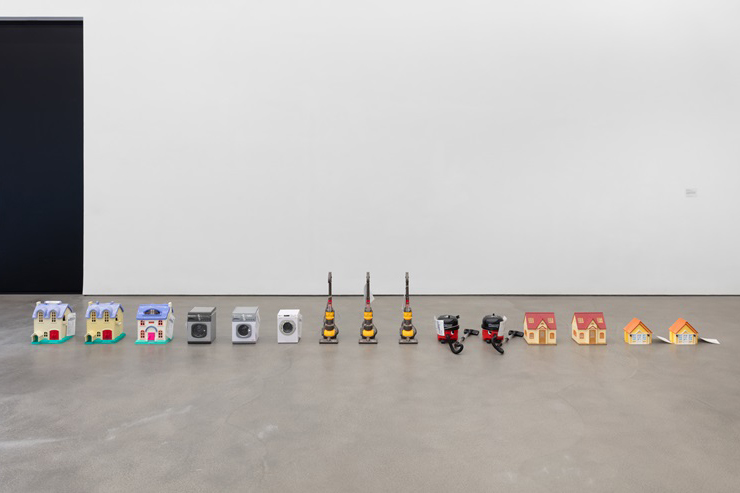There is one month left to see the Turner Prize exhibition at Eastbourne’s innovative Towner Gallery. SOURCE went along to take a look and see what the locals thought about the contemporary art show.
A typical reaction upon entering this corner-plot gallery for the first time is: “how is it this big inside?” Architect Rick Mather’s cunningly designed building is reason enough to visit, with curved walls that incorporate blank canvas rooms designed for housing contemporary art. For the duration of the Turner exhibition each of the shortlisted artists have filled one room of the three-storey building with their work.
It can feel as if the main ambition of the Turner Prize is to ignite a debate about the value and validity of contemporary or ‘modern’ art, and to some degree the 2023 nominees do that well. In the interests of balanced opinion, SOURCE followed up the gallery visit with a quick pint in the town’s record shop bar, The Frontier Bar, and asked some regulars for their views while they sipped craft ales.

First, the art. Tucked into the corner of the Towner’s entrance floor, Ghislaine Leung’s work presents a series of statements on, well, something? Industrial ducts, a tin fountain, a set of plastic children’s toys bearing cataloguing labels, a baby monitor fixed to the wall. Of the four entries, this work provokes the most typically Turner-esque “is it art?” reaction. It’s hard to spend any length of time with the pieces without feeling a little underwhelmed and daft. Vigilant volunteers guard the doorway and we can’t help thinking of all the excited toddlers and children who have been told that they can’t play with the toys.
On the far wall, in the form of a grid of lines, is a key to unlock the room if anyone takes the time. Few seem to even notice it. Leung’s graphical creation represents the precise size and relative availability of the space they, as an artist, can occupy – but the key seems at odds with the bric-a-brac nature of the pieces surrounding it. It’s here that the line between art-as-meaning and art-as-aesthetic begins to reveal something.

A purpose-built cube on the first floor hosts Rory Pilgrim’s entry. The video component dominates and the benches are frequently full. Depicting community-sourced performances, the work is hard to penetrate. Images from the video are installed inside the viewing space. Most of us stick our heads in politely and trundle past. When audiences deem art to be primarily aesthetic, then video installations are often skipped over. Later, the pub-punters agree: “If they put it on Netflix I’d have a look, but I don’t want to sit down and watch hours of film in there.”

On the top floor, with stunning views of the Sussex countryside, we find works by two artists presented in adjoining rooms. Enter through the first door and you walk into Jesse Darling’s chaotic representation of post-Brexit UK life. This is what ended up winning the coveted prize. Metal railings twist across walls from broken and exposed concrete strewn with cheap hazard tape and tumbling piles of folders. Look closer and you’ll discover carefully placed lacework, ribbon-bound antique tools, and obscured and ineffective warnings amid the wreckage. There’s a silence in this room among the visitors, not found in the Leung exhibit. This is England, and it’s easy to feel the resonance.

Next door, visitors stand or sit solemnly before Barbara Walker’s hand-drawn mural depicting victims of the Windrush scandal. Enlarged documents, overlaid with the faces of the affected, line the walls. If art is meaning, there is no ambiguity here. If art is aesthetic, the simplicity, execution and delivery is accessible to all. The team at the Towner have fought the local community’s more traditional thinkers ever since the gallery opened, and they know the power of curation and staging. As a complementary experience that highlights the purpose and value of art, Walker and Darling’s proximity throws questions of ‘winning’ and ‘prizes’ into the background and most visitors leave murmuring to each other sentiments of sadness and politics.
Once in the pub, the bants polarise around the most easily evaluated aspects of the show: Walker’s drawings are stunning and meaningful (and therefore appreciated) and the ducts are just dumb because “anyone could do that”. After a while the conversation becomes more subtle and a quiet appreciation for the winner emerges. Darling’s work has resonance with this community as it features sculptural elements and personal craft alongside the wilder, button-pushing hazard tape and ‘trash’. Contemporary art, at its best and worst, is rightfully provocative. What starts as a day out to “see what all the fuss is about” ends with a table of strangers discussing the moral rights and wrongs of a world they all wish to see improved.
The Turner Prize exhibition at The Towner Gallery in Eastbourne is open until 14th April 2024
More info here

